

New employees usually start off highly engaged. But after the first year employee engagement can significantly drop. This trend is what we call the “tenure curve.”
This phenomenon matters because experienced and talented employees are highly valuable. Organizations put a lot of time and money into recruiting, hiring, onboarding, and training new employees. This makes it very expensive to replace a tenured employee.
Retaining your tenured talent is crucial to a healthy bottom line. So how do you keep tenured employees engaged beyond the honeymoon phase?
In this article we will discuss:
The tenure curve is an employee engagement trend seen in many organizations. When we map the data, the tenure curve appears as a U-shaped graph, demonstrating how an employee’s engagement changes over time.
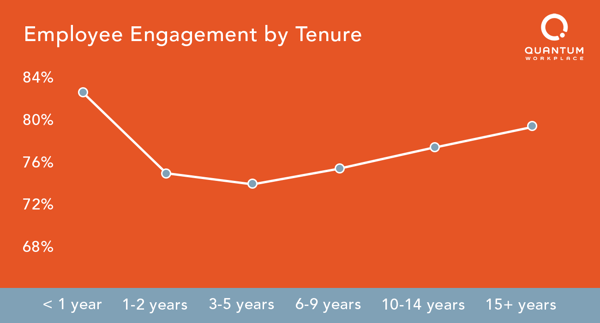
Employee engagement is typically highest for the newest employees, takes a nosedive after year one, and doesn’t increase again until after 5 years or more on the job.
There are many reasons engagement may fluctuate over time. To better understand the implications of the tenure curve, let’s break down employee engagement trends within each group and their key drivers.
New hires are typically some of the most engaged employees. These employees go through a lot of development and adjustment in a short amount of time. They have to acclimate to a new culture, quickly learn organizational procedures, and adapt to new technologies—all while navigating personal and professional relationships within the organization.
Despite being bombarded by new expectations, rules, and relationships, new hire engagement is often off the charts. These higher levels of engagement are likely related to the novelty and optimism associated with a new workplace.
The new hires are going through a honeymoon phase—focused on limitless possibilities, receiving tons of attention, and learning a lot about their new workplace and coworkers.
At one to two years on the job, the shine on the relationship starts to dim. In this phase, employees might:
Any combination of these things can lead to employees becoming disillusioned with their job.
One reason for this large drop in engagement may be explained by the concept of the psychological contract. The psychological contract describes the beliefs and commitments that exist between an employer and an employee. When there is a perceived breach in the psychological contract, employees experience a violation of trust and expectation, which can lead to disengagement.
Employees in the 1-2 year bracket likely believe that they should continue to receive the learning opportunities and attention they enjoyed during their first year. When that “contract” is broken, employees feel a bit abandoned. They begin to wonder if their jobs are really all that great or if the organization really cares.
Over the next few years, many employees hit a ceiling. Often this means there is a limit on employee advancement, whether it be career development via promotions and increased responsibility or professional growth via acquiring new skills and knowledge.
Without a clear path forward, engagement is slow to increase.
Employees in this stage aren’t just an employee at the organization—they are the organization. They have stayed with an organization through ups and downs, changes in personnel and strategies, and redefinitions of competitive landscapes.
It is at this point that we see engagement increase again.
Long-term employees are more likely to hold higher positions of formal or informal influence within the organization, which further strengthens their desire to support, protect, and guide the organization.
So how do you keep tenured employees engaged past year one?
For the success of your organization, it is crucial to maintain the high level of engagement that comes with a new hire. Let’s take a look at engagement drivers across tenure.
There are certain drivers that are constant throughout tenure, including:
These are in the Top 5 drivers of engagement for all employees across all tenure groups. They are core to engagement, no matter an employee’s tenure. These drivers should be integrated into your overall engagement strategy as you target other drivers for specific tenure groups.
This driver is very important in the first year, then drops. But it spikes again at 15+ years. Employees always want to have a voice, but it’s especially important for brand new and well-tenured employees.
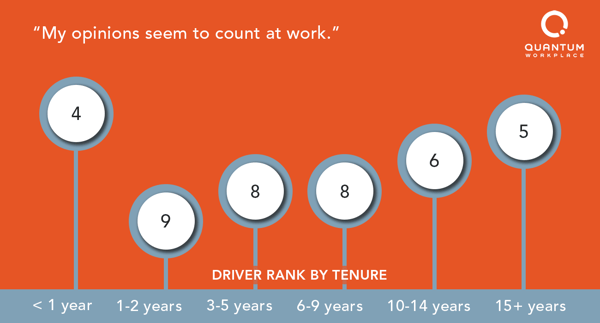
Surveys are a great way to understand how well your engagement strategies are working and identify areas of opportunity. Keep tabs on your tenured employees’ engagement by conducting engagement surveys at least once a year.
Even better, keep a pulse on what’s happening throughout the year with shorter pulse surveys. Pulse surveys can be launched on any topic, any time. They are especially useful for following up on challenges and opportunities that surface in your engagement survey results.
At a minimum, make sure to launch an annual engagement survey. If an engagement survey is conducted on a less-frequent timeline, then you may miss collecting key feedback from an entire generation of new employees. Without fresh data and insights, you could be shaping new hire and onboarding strategies based on data that are 18-24 months old. Thus, surveying on an annual cycle is paramount for a successful engagement strategy.
This driver starts higher for new employees and slowly gets less important across tenure. New hires want a career (versus a job) and as their job develops into a career over time, it becomes less important to more tenured employees.
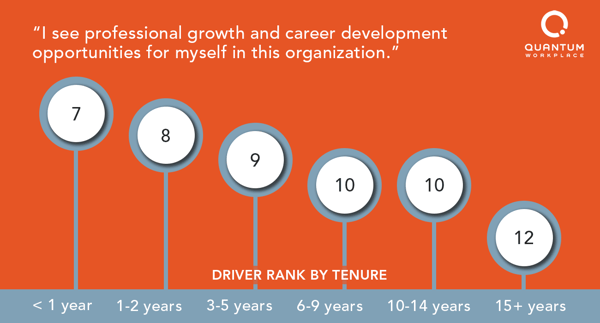
Don’t wait too long to check in on your employees. Regular (monthly or quarterly) one-on-ones and high-quality performance conversations reinforce the relationship between the employee and the organization and help you support their work specifically and meaningfully.
Regular check-ins can also ensure that all employees are well-informed about the organization’s future and how they individually fit within that future.
Both of these drivers increase sharply after Year 1 and through Year 5. After the first year, employees tend to put the organization under a microscope. If they don’t feel they are being recognized for their work, or that the leaders of the organization care about their people, they’re likely to start looking for opportunities elsewhere.
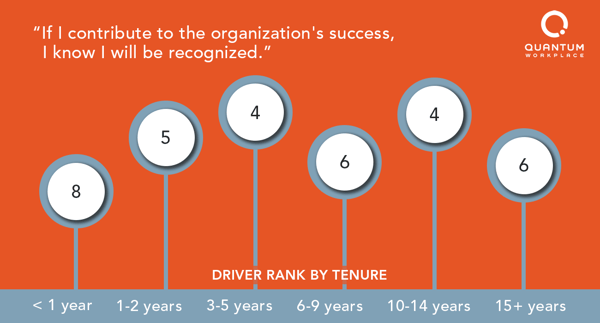
Recognition is key to engaging employees who are past the honeymoon phase but not yet fully settled into their role.
Build recognition into the way you manage. Make time for both formal and informal recognition, such as a shoutout to an employee for a job well done during a team standup meeting or a public recognition post in front of the entire organization.
This driver spikes at 10-14 years. It’s important to keep tenured employees on their toes by finding new ways to challenge them in their roles.
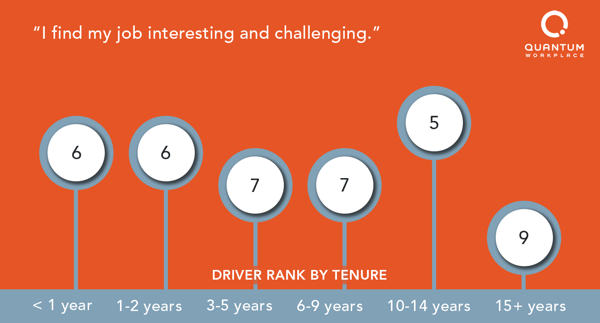
Keep your employees engaged year after year by investing in their career development. Share opportunities for additional training, certification, or responsibilities with your employees. Talk with them about their long-term career goals and work together to map a path within the organization.
Half the battle is avoiding burnout and boredom. Keep things interesting by making sure your employees have stimulating challenges and growth opportunities at every level.
This driver becomes increasingly important over time. Frequent communication and feedback are key to helping employees feel connected and informed. Don’t stop paying attention to an employee just because they’re doing well or have been around for awhile.
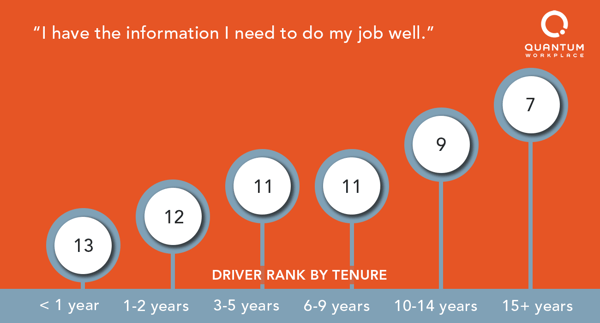
Create a feedback culture on your teams and throughout your company to encourage honest communication. When employees trust their manager and organization to listen, they are more likely to share feedback and insights into their work—including communicating about what resources and support they need to succeed.
During the first year this driver is ranked low, but rises in importance across tenure. New employees might not be too invested in goals and accountabilities as they are getting up to speed. But once they are settled in, they’re going to want clear direction and goals to help them understand how they are performing and contributing to the organization’s success.
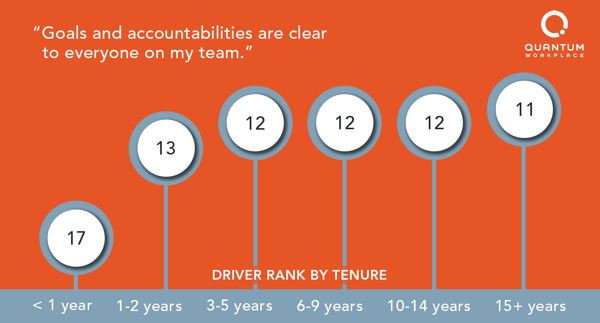
As you meet with your employees, discuss team and individual goals as well as your expectations. Help align their goals to the company’s mission so their work feels relevant and significant. By keeping your employees in the loop and helping them tie their goals to the organization’s strategy, they will feel more positive about their contributions and optimistic about the future.
Engaging employees consistently over time is no small task. But by surveying regularly and understanding key engagement trends within different groups, you can create more effective strategies for engaging employees year after year. Download our ebook, A New Era of Employee Engagement, to learn more ways to move the needle on engagement.
Published July 16, 2020 | Written By Kristin Ryba